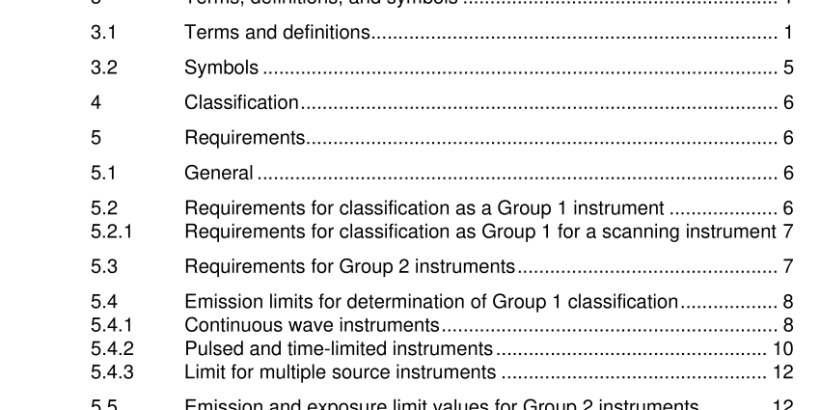ANSI Z80.36-2016 pdf download.Light Hazard Protection for Ophthalmic Instruments
5.2 Requirements for classification as a Group 1 instrument An ophthalmic instrument shall be classified in Group 1 if any or all of the following criteria apply.
a) An International Standard exists for the instrument type but no light hazard requirements are included in that International Standard;
b) Its components, e.g., lamps, light-emitting diodes, non-removable filters, lenses, fibres, etc., prevent emissions in excess of the limits specified for instruments in Group 1 and certification of this exists. Such instruments shall be classified as Group 1 by virtue of the test certification by the manufacturer of the components themselves without the need for further measurements. If such components prevent some, but not all emissions to exceed the limits specified for Group 1 , then measurements shall be required only for those parameters in tables 2 and 3 where the components do not prevent the limits from being exceeded;
c) Its emission values are equal to or less than the limit values given in 5.4. The test methods used for determination of compliance shall be in accordance with 6.2; d) It is a dose-limited instrument by virtue of its construction and design, as defined in 3.1 .3.
Existing International Standards that contain light hazard requirements are listed in annex B. The limit values to determine Group 1 classification are based upon an expected exposure time for the instrument type under consideration. The Group 1 limit values given in 5.4 are based upon a 1 h exposure. These limits apply to all instruments except operation microscopes, endoilluminators, and instruments designed for continuous exposure. For instruments designed for continuous exposure, the limits should be reduced by a factor equal to one half of the continuous exposure time, in hours, associated with the intended use of the instrument. Dose-limited instruments fulfil the Group 1 requirement for retinal photochemical aphakic light hazard weighted retinal irradiance, E A-R , if their maximum exposure duration is less than the time to reach the recommended maximum exposure for photochemical aphakic retinal exposure, t max , in accordance with 6.5.3.
5.3.1 If an instrument does not fulfil all requirements for a Group 1 instrument, it shall be checked for compliance with Group 2 requirements only for those hazards for which it did not fulfil the requirements of Group 1 . The reporting requirements of clause 7 (b) need only be complied with if Group 1 requirements are not fulfilled for 5.4.1 .1 – Weighted corneal and lenticular ultraviolet radiation irradiance (table 2), or 5.4.1 .2 – Unweighted lenticular ultraviolet radiation radiant exposure (table 2), or 5.4.1 .3 – Retinal photochemical aphakic light hazard, Weighted retinal irradiance (table 2). Visible light is necessary for diagnosis of ocular pathology, and thus is commonly used in instruments such as direct and indirect ophthalmoscopes, slit-lamp microscopes, operation microscopes and endoilluminators. It is not reasonable to set limits on visible radiation that is needed for the diagnosis of disease or for visualization during ocular surgery. A surgeon may have to exceed an exposure level that is known to be potentially hazardous during an extended complicated surgery or a clinician may have to exceed an exposure level that is known to be potentially hazardous during an extended ocular examination for diagnosis of ocular pathology. With this in mind, the standard requires that the time to reach a potentially hazardous exposure be given, rather than to set a limit, so that clinicians are informed about potential optical radiation hazards that may be associated with the use of their instruments should they need to use an amount of radiation that has a high likelihood of causing ocular tissue damage.ANSI Z80.36-2016 pdf download
